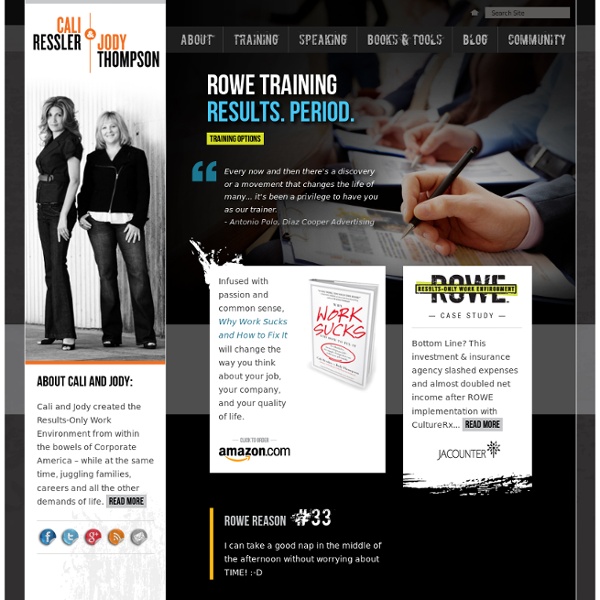



ROWE See also[edit] References[edit] External links[edit] CultureRx - Official Trainers of the Results-Only Work EnvironmentWashington Post Article"video". CNBC. June 11, 2008. Seth's Blog Are You An Armchair Creative? I’m from Britain, so the rules of American football are a mystery to me. But even I know “armchair quarterback” is not a compliment. It means someone who sits on the sidelines, watching and criticizing instead of doing.As creative professionals, we pride ourselves on doing — making ideas happen — instead of passively consuming, like the couch potatoes with their remote controls. But there comes a point where leaning further forward won’t get you much further. In my office there are two chairs: my swivel office chair in front of the desk; and the comfy armchair by the window, flanked by my bookshelf and the stereo. But the thing is, the time I spend in the armchair is usually some of the most creative and productive time in my whole week. The armchair takes me into a different space, where my mind can drift and I can see the big picture of the projects I’m working on, notice the patterns that emerge and my gut feeling about the best way forward. 1. 2. 3. 4. 5. 6.
Be a Volunteer If you’re a man or a woman over the age of 18, you can be a Girl Scout volunteer. No matter what your background might be, what your interests are, or the amount of time your schedule allows, Girl Scouts of San Gorgonio Council wants and needs your talents, experience and energy to benefit the growing number of girls who are or want to be Girl Scouts. As a volunteer, you can choose from several flexible Girl Scout Pathways—the ways that girls and adults participate in Girl Scouting—which offer you the freedom to tailor your level of involvement to fit your schedule and lifestyle. Not sure what you’d be doing as a valued Girl Scout Volunteer? Be a mentor by guiding girls to explore their interests and learn about possible careers. Speak about the Girl Scout organization to community groups or college community service centers. Provide administrative assistance and supervision in registering participants for events.
5 Lessons That Professor Failure Taught Me About Success Failure has become a faithful friend throughout the years. Early on in my life I thought failure was my mortal enemy. But life’s experience has taught me that Professor Failure is on the academic staff of my personal University Of Success that I attend. He is a vital necessity for my training, in order to become someone who will reach his full potential, and even go beyond what he personally thought possible. And why is that? Those lessons then become the building blocks for the success I have experienced to date, and the success that will accompany me for the rest of my days. So please allow me to share with you just 5 lessons that Professor Failure has taught me about success. The Importance Of ObsessionIf you ever want to make your mark on this world, you are going to have to break free of mediocrity and be obsessed. So that is my call to you today. Are there any other lessons that Professor Failure has taught you, and could help others to graduate from the University of Success?
Journeys A key part of the Girl Scout Leadership Experience is the leadership journey, a coordinated series of activities grouped around a theme. Each journey is tied to some of Girl Scouts' 15 national outcomes for girls. These outcomes are integral to the three leadership keys : Discover, Connect, and Take Action. Journeys provide "sample sessions" to give girls and volunteers ideas about sequencing experiences, discussions, and earning awards so that the "whole" feels like one big adventure. The journey will be much more fun and relevant as girls make it their own! Coming Soon! Journey Awards In a Girl Scout journey, awards link experiences, discussions and ideas that girls explore together. All the steps girls take toward earning awards are built right into the journey.
Five Ways to Become Happier Today | Tal Ben-Shahar Transcript Question: What can people do each day to be happier? Tal Ben-Shahar: The first thing to do to become happier, paradoxically, is to accept painful emotions, to accept them as a part of being alive. You know, there are two kinds of people who don't experience painful emotions such as anxiety or disappointment, sadness, envy; two kinds of people who don't experience these painful emotions. They are the psychopaths and the dead. So if we experience painful emotions at time, it's actually a good sign. Question: Are there specific things people can do? Tal Ben-Shahar: Then I think -- yeah. Physical exercise contributes a great deal to happiness; in fact, there is research showing that regular exercise, three times a week for 30 to 40 minutes of aerobic exercise, could be jogging or walking or aerobics or dancing, three times a week of 30 to 40 minutes of exercise is equivalent to some of our most powerful psychiatric drugs in dealing with depression or sadness or anxiety.